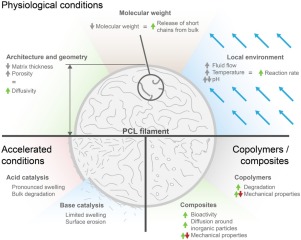Progress in Polymer Science ( IF 27.1 ) Pub Date : 2019-05-28 , DOI: 10.1016/j.progpolymsci.2019.05.004 Michal Bartnikowski , Tim R. Dargaville , Sašo Ivanovski , Dietmar W. Hutmacher

|
Polycaprolactone (PCL) is a biodegradable polymer that is widely utilized for biomedical applications, as well as for environmentally sustainable packaging. The mechanisms driving PCL degradation appear to be overall variably documented and investigated, despite the potentially significant influence that aspects such as synthesis, end-group chemistry, molecular weight, and crystallinity, both before and after melt processing, may have on the behavior of the polymer over time. In this review, we identify mechanisms of PCL degradation across a range of mainly biomedical applications, exploring the role of the polymer structure and form, radical interactions, temperature, pH, enzymatic activity, and cellular phagocytosis. We examine how polymer chemistry has been used to alter PCL degradation rates and mechanisms, and present cases where such manipulations may affect the applications of PCL. We also comprehensively discuss the literature assessing the degradation of PCL in vitro and in vivo, and present a summary of the correlations and trends between the data. Significantly, our analysis identifies currently undescribed trends in PCL degradation. Namely, we observe that molecular weight decreases at a consistent rate regardless of the initial value, and does so at a linear rate in vitro and an exponential rate in vivo. Both mechanical properties and mass loss are strongly influenced by construct geometry and environmental conditions.
We further assess the current biomedical literature on the degradation of PCL copolymers and its composites. The formation of novel PCL copolymers or composites is often used to broaden the versatility and applicability of the polymer, although this approach is rarely explored beyond initial research. Novel biomaterials overall rarely emerge from research, with inherent issues such as the reproducibility of synthesis, manufacturing, or characterization methods and outcomes further impeding their translation. We conclude the review with a summary of the current state of the tailorability of PCL-based polymers and composites, and offer recommendations for the future research direction of the field.
中文翻译:

化学,几何和环境条件下聚己内酯的降解机理
聚己内酯(PCL)是一种可生物降解的聚合物,广泛用于生物医学应用以及环境可持续包装。尽管在熔融加工之前和之后,诸如合成,端基化学,分子量和结晶度等方面可能对聚合物的性能产生潜在的显着影响,但驱动PCL降解的机理似乎总体上被可变形式记录和研究。随着时间的推移聚合物。在这篇综述中,我们确定了PCL在主要生物医学应用范围内降解的机制,探讨了聚合物结构和形式,自由基相互作用,温度,pH,酶活性和细胞吞噬作用的作用。我们研究了如何利用高分子化学来改变PCL的降解速率和机理,以及当前这种操作可能会影响PCL应用的情况。我们还全面讨论了评估PCL降解的文献体外和体内,并总结了数据之间的相关性和趋势。重要的是,我们的分析确定了PCL降解中目前未描述的趋势。即,我们观察到分子量无论初始值如何都以恒定的速率降低,并且在体外以线性速率并且在体内以指数速率降低。机械性能和质量损失都受到构造几何形状和环境条件的强烈影响。
我们进一步评估了有关PCL共聚物及其复合物降解的生物医学文献。新型PCL共聚物或复合材料的形成通常用于拓宽聚合物的通用性和适用性,尽管这种方法很少被用于最初的研究之外。总体而言,新型生物材料很少来自研究,其固有问题是诸如合成,制造或表征方法的可再现性,其结果进一步阻碍了它们的翻译。我们以PCL基聚合物和复合材料的可定制性的当前状态的总结作为总结,并为该领域的未来研究方向提供建议。



























 京公网安备 11010802027423号
京公网安备 11010802027423号